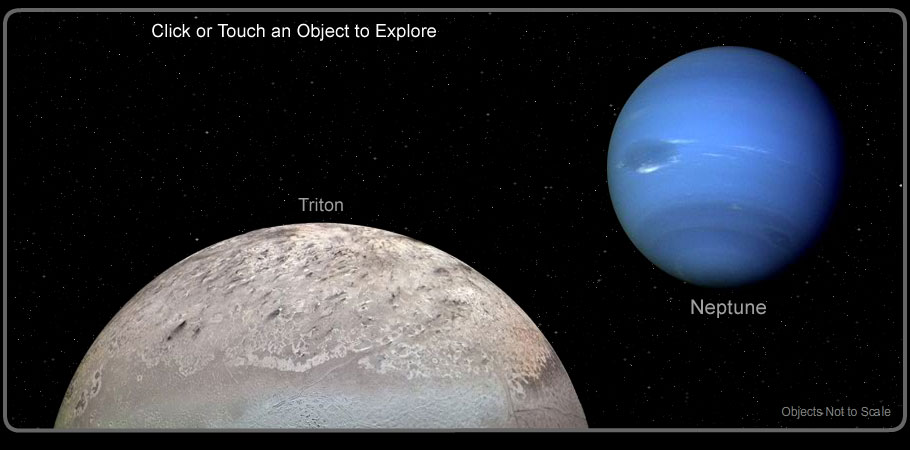The Blue Gas World
As we leave behind the blue green beauty of Uranus, we encounter another giant blue world of almost the same size. This one is a bit different in appearance, however. Unlike its rather unremarkable distant sister, this giant sphere is marked by wispy white clouds and dark blue spots. Like a giant eye it looms up from the blueness, reminiscent of the great red spot on Jupiter. A few tiny rings and 13 moons encircle this planet. One of these moons, Triton, is quite large, and invites further investigation. This is the planet Neptune and its system of moons.
And Yet More Rings
Like its sister planet, Uranus, Neptune has a very thin, dark system of rings. These rings were first observed in 1968 by a team of astronomers led by Edward Guinan. When the rings were first discovered, they were thought to be incomplete ring segments. It was suspected that these rings might have gaps after observation of a stellar occultation in 1984. Similar to the ring discovery of Uranus, the star flickered as the rings passed in front of it. But astronomers were confused when the star failed to flicker again as the planet passed it. In 1989, the Voyager 2 spacecraft finally settled the issue by revealing several faint, complete rings around the planet. These rings were, however, discovered to have a mysterious clumpy feature that is not yet fully understood. This may have something to do with the gravity of some of the small moons that orbit near the rings.
Like the rings of Uranus, the rings of Neptune are very thin and dark. They are thought to be composed of a mixture of ice and some type of dark material, possibly containing some organic compounds. The Voyager 2 spacecraft observed five distinct rings. Astronomers believe these rings to be fairly young. They may have been formed when a small moon was pulverized by some unknown catastrophe.
A Dynamic Atmosphere
Perhaps the most exciting discovery made by the Voyager 2 encounter was that of Neptune's unusual cloud features. Astronomers were expecting Neptune to be bland and featureless like its sister planet, Uranus. Instead, they were amazed to find many detailed cloud features in the planet's atmosphere. The most striking of these was the giant dark blue spot, which looked very similar to the giant red spot on Jupiter. Other smaller blue spots were visible along with swirls and bands in the clouds. These dark spots are believed to be holes in the upper atmosphere that allow the darker clouds to show through. These dark clouds are thought to be composed of hydrogen sulphide. The great dark spot was originally thought to be a long-lasting feature like the one on Jupiter. But in 1994, the Hubble space telescope turned its eye toward Neptunian system and discovered that this giant spot had vanished.
Voyager 2 also photographed fluffy white clouds in Neptune's upper atmosphere. These clouds were high enough to cast shadows on the cloud deck below. The high altitude clouds photographed by Voyager 2 are thought to be composed of primarily of methane. These white clouds are extremely dynamic, and have been observed forming and then dissipating in a matter of hours.
Exploring the Neptunian System
The Neptunian system was first observed by Galileo in 1612. Because the planet moves so slowly, Galileo thought it was a star. In 1821, French astronomer Alexis Bouvard noticed that some strange force seemed to be affecting the orbit of Uranus, but he was never able to find the cause. It was German astronomer Johann Gottfried Galle who finally figured out that what was once thought to be a star was actually a planet and its gravity was affecting the orbit of Uranus.
The Neptunian system has only been explored by one spacecraft. Voyager 2 made its closest approach to the planet Neptune on August 25, 1989. By the time the spacecraft reached Neptune, it was traveling over 40,000 miles per hour (about 64,000 kilometers per hour). The light from the Sun was so dim that extremely long exposures were required to obtain photographs. From this distance, data from the spacecraft took 246 minutes to reach Earth. Some last-minute reprogramming by the science team was able to overcome these obstacles, and Voyager 2 send us our first close-up views of Neptune and its largest moon, Triton.
During this brief flyby mission, Voyager 2 confirmed the magnetic field around Neptune and discovered that it is actually offset from the center of the planet. The spacecraft also sent back images of unusual cloud features such as dark blue spots and wispy white clouds in Neptune's upper atmosphere. The winds on Neptune were found to be the fastest in the Solar System. Near the great dark spot, wind speeds were measured at an astounding 1,200 miles per hour (nearly 2,000 kilometers per hour). The reason for such high wind velocities is still unknown.
There are currently no immediate plans for a future mission to the Neptunian system. NASA is, however, considering another mission to the giant planet in the long term. This next mission would like involve a nuclear powered spacecraft that would be sent to explore Neptune and its moons in detail. But with other higher priorities looming, this mission could be as much as 30 years in the future.




